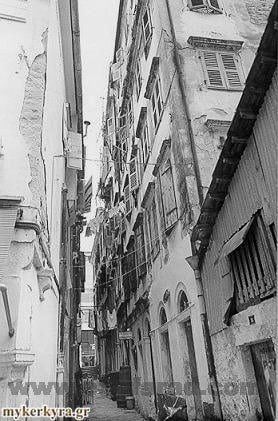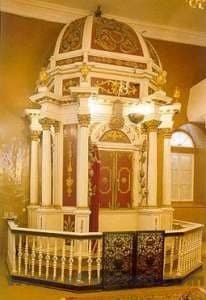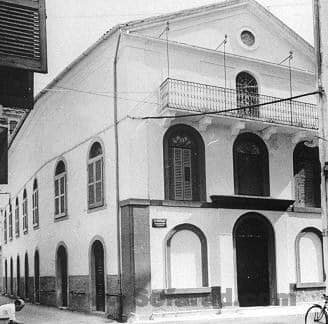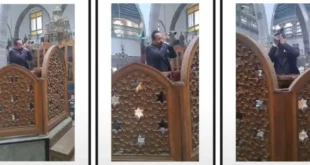The first written testimony on the presence of Jews in Corfu is found in the «Itinerary» of the Spanish Rabbi Benjamin Ben Yonah, who wrote that, during his visit to the island of Corfu in the 12th century, he met a Jewish dyer named Joseph.
Later on, historians noted that in 1267 «numerous Jews lived in the island». That year the island was conquered by the House of Anjou (1267-1336), a period during which Jews who numbered several hundred, faced the population’s hostility. Therefore, the Princes passed decrees in order to protect them.
In 1387 the Venetians occupied the island for a long period of time. In 1425 they forced the Jews to live among Gentiles in various quarters.
In 1492, some of the Sephardic Jews who were expelled from Spain settled in Corfu. In 1494, the expelled Jews from Apulia (Italy), and in 1589, some former «Marranos» from Portugal, led by Don Samuel Senor joined them. The new immigrants wished to integrate to the local «Romaniote» community. The Romaniotes, however, did not agree for fear they would lose certain privileges they had gained in the meantime. So, in 1551, the immigrants formed the new «Apulian» community. They lived within the citadel and had their own synagogue and cemetery.
In 1571, when the Venetian State decided to expel the Jews from its territory, the Jews of Corfu were exempted, because according to the resolution of the Senate «This Jewish Community has proved beneficial to the city and to the island».
On February 9, 1602, the Venetians passed a decree imposing a «badge» on Jews, which was a yellow cap for men and a yellow head cover for women, or a round yellow badge. In 1622, the ‘General Pronoitis of the Seas’, passed a decree imposing new restrictions, which led to additional decrees on March 1, 1707.
These decrees were abolished when the Democratic French occupied Corfu between 1797-1799, granting certain privileges to the Jews, still valid when the Imperial French invaded the island in 1807.
The British seized Corfu in 1814, limiting some of the Jews’ privileges until the island was incorporated to Greece on June 2, 1864. The State granted them equal rights to the rest of the population.
On April 2, 1891, the Jewish Community -composed of 5,000 people- suffered a terrible blow of anti-Semitic incidents due to religious superstitions, commercial competition and political interests. During these incidents the mob engaged in attacks against the Jews, looting of houses and shops, and a stunning violence. Many Jews were forced to emigrate to Egypt, France, Italy, England, etc.
Since then, the Romaniote and Apulian Communities that had been separate, were integrated.

The Jewish Quarter
Since the earlier years the native «Romaniote» Jews lived on «Kambielou» hill, later called «Ovriovouni» or «Ioudaico Oros», or «Hebraida» («Jew hill» or «Mount Judaic»). This is the name by which it is still known today. The immigrants lived within the walls.
When the 1525 decree for the settlement of Jews in the area of «Spilia» («Cave») weakened, the ‘General Pronoitis of the Seas’ passed a harsher decree that forced the Jews to move permanently to a quarter that today is defined by Vilissariou Street, Aghias Sophias Street and Palaiologou Street. It was in this densely populated area with many shops that the Jews began developing their religious life and professional activities.
The Synagogues
In 1537 the first synagogue built by immigrants, «Kahal Kadosh Italiano Corfiato», or else «Poulieza», was destroyed. Another synagogue called «Vecchia» or «Midrash» was built in the Jewish quarter on Palaiologou Street. In 1926 it was burned down and reconstructed to be destroyed again by the German bombing on September 12, 1943.

When the Romaniote Jews left the «Kahal Kadosh Toshavim» or «Greca» Synagogue on «Ovriovouni», during the British domination, they built the «Nuova» or «New» Synagogue, where services are still held today on 4, Velissariou Street. The Community offices and the hall for funeral services are housed on the ground floor.
Learned rabbis held offices in the Synagogues. The last rabbi to hold an office was Rabbi Yakov Nehama (October 13, 1931 – June 8, 1944), who was arrested by the Nazis and was deported to Auschwitz like the rest of his congregation.

Cemeteries
Each Community had its own cemetery.
The Romaniote cemetery was on «Avramiou Hill» towards the slope of the new citadel. This area was donated by Marshal Scholemburg «as a gesture of gratitude to the Jews for their bravery and gallantry during the Turkish siege in 1716». The Sephardic cemetery was close to the Romaniote one, in «Saroko» area towards the Holy Monastery of Platytera. In 1502 it was ceded by the Venetians in return of land. During the Occupation, both cemeteries were vandalized and destroyed by the Germans. The new cemetery still functioning today is located in the area called «Cephalomandouko» next to the Catholic cemetery.

Home for the Aged
Before World War II the Community ran a Home for the Aged on Scholemvourgou Street, but the building was destroyed in the German bombing in 1943.
The Jewish school and education
In the 13th century, Corfu became a center of study of the Torah. The «Ionian Academy» had a Hebrew language faculty. According to an article of a local newspaper dating December 31, 1824, two legacies were left to the «Talmud Torah School» so that it could continue functioning. One of the learned rabbis, Rabbi Yehuda Vidas, who served in the school between 1832-1852, contributed to the academic reformation.
In spite of the Community’s financial difficulties, the school continued holding sessions until the beginning of the 20th century. In 1915, Chief Rabbi, Abraham Schreiber, assisted by teacher Moissis Haimis, founded an evening school for the needy Jewish pupils to whom the Community offered free meals. His efforts succeeded and the number of pupils who attended rose from 30 to 230. In 1925 Rabbi Schreiber founded a Rabbinical School.
The course of studies that the Jewish pupils followed in elementary education continued in the Third Grade School and as of 1931 it continued in the Fifth Grade School, which included a kindergarden. Hebrew and Italian were instructed in addition to the Greek language. In the academic year 1939-40, 208 boys and girls attended the elementary school and 76 attended the kindergarden. During the War the school attendance decreased until the Nazis persecuted and arrested all the Jews and deported them to the concentration camps.
Occupations
According to the commercial guides of the city of 1902 and 1930, we may conclude that the Jews of the island practiced various professions. Olive oil exporters, soap manufacturers, umbrella manufacturers are some of the occupations they were in. In addition there was one doctor, one lawyer and one notary. The Jews covered all the spectrum of commerce, small industry and trade.
Iosif Nahamoulis was a leading printer, who used modern printing equipment in order to publish religious and other books. As of 1861 he published the «Israilitika Chronika» («Jewish Chronicles») magazine and as of 1864 he published the «Israilitiki Oikogeneia» («Jewish Family») magazine. In 1899 his printing-house published Moissis Haimi’s magazine, «Israilitikos Chronographos» («Jewish Columnist»).
In fact, the Jews’ contribution to the commercial and financial development of the island was significant.
Associations
In 1898 the «Omonoia» («Harmony») Association was founded and in 1906 the Zionist Association «Megith Nirdanim» started functioning. Later it was renamed «Tikvat Tsion» and even later «Theodor Hetzl». In 1931 one more association, «Afixi Photos» («Light coming») was founded.
Figures
In the early years of their settlement on the island, the Jews played a leading role in its financial, social and spiritual life. They were especially patriotic and heroic. Isaac Abdelah who fought during the Turkish siege in 1716, Daniel Bessos who fought in the Battles of Bizanio and Solomon Mordos who fought in the Albanian Front were a few examples. Young Jewish men participated in all the wars in order to defend the island and the homeland, and prosperous families donated great sums for the struggle of the Greek nation.
Some of the most important figures were David Semos, 1385; Lazaros de Mordos a doctor philosopher; Caesaras Vivante, Solomon Rieti; Caesaras and Emilios Ouzilio; Iosif Fould; Donna Besso; the Olivetti family and many more.
At times, Jews such as Elias and Theophilos de Mordo, Rafael Yeshouah, Victor de Semo, Savinos Dentes and Iosif Nehamoulis, were elected in the local government. The intellectual painter Julio Kaimis, University professor Lazaros – Menahem Belelis and the well-known author Albert Cohen were spiritual children of Corfu.
The Persecution
When Italy surrendered to the Allies, the island was occupied by the Germans on September 27, 1943. After a period of deceptive calm, on June 8, 1944, an ordinance was passed, according to which all the Jews were to remain in their homes.
About two hundred Jews succeeded to flee. On the dawn of the following day, the Germans arrested all the others and deported them to Auschwitz via Athens. The Nazis and the mob looted their homes and shops. Out of 1900 Jews of Corfu, about 180 survived the Holocaust. Many of them emigrated to Israel or settled in big cities. In 1946 the Community had 140 members; the Synagogue and the school were almost ruined. As time passed the Community re-formed and resumed normal life. Today it is composed of 65 members who continue their course.
Source: Central Board of Jewish Communities in Greece
[print_link]
 eSefarad Noticias del Mundo Sefaradi
eSefarad Noticias del Mundo Sefaradi

